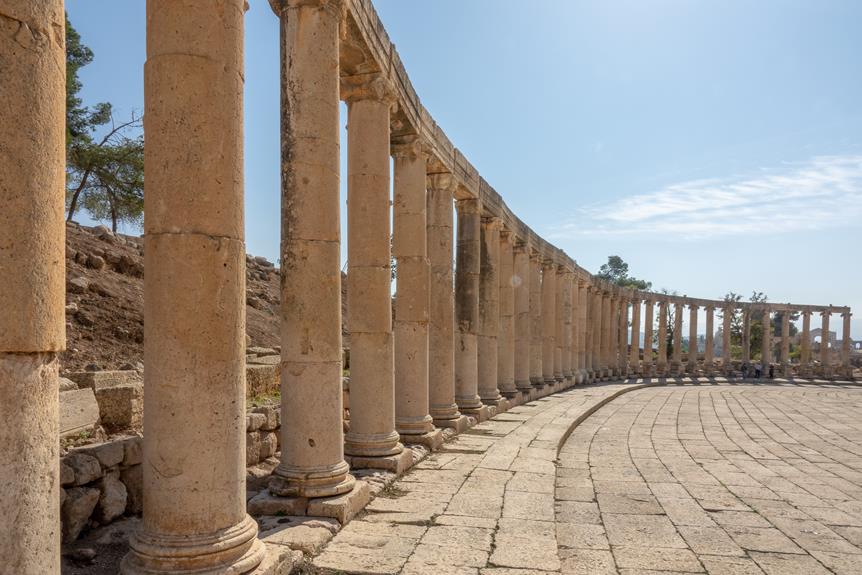
As a history enthusiast, I have explored countless Roman historical sites around the world. But let me tell you, Spain is a treasure trove of must-see locations that will leave you in awe. From the towering Segovia Aqueduct to the majestic Tarragona Amphitheater, these sites transport you back in time. Get ready to be amazed by the Merida Roman Theater, Italica Archaeological Site, and Baelo Claudia Roman City. Let's embark on an unforgettable journey through Spain's rich Roman heritage.
Key Takeaways
Table of Contents
- The Segovia Aqueduct is one of the most iconic and well-preserved Roman aqueducts in the world, supplying water to Segovia for over 1,800 years.
- The Tarragona Amphitheater, built in the 2nd century AD, reflects the power and influence of the Roman Empire and provides a glimpse into the culture and traditions of the past.
- The Merida Roman Theater, with its capacity to accommodate up to 6,000 spectators, showcases the Romans' mastery of engineering and allows visitors to imagine lively performances from the past.
- The Italica Archaeological Site, home to one of the largest Roman amphitheaters in the world, preserves beautifully intricate mosaic floors and immerses visitors in the rich history and ancient architecture of the Roman Empire.
Segovia Aqueduct
I was amazed by the Segovia Aqueduct when I visited Spain during my trip to explore Roman historical sites. This Roman engineering marvel, with its towering arches and impressive structure, stands as a testament to the advanced engineering skills of the ancient Romans. Built in the 1st century AD, the aqueduct played a crucial role in supplying water to the city of Segovia for over 1,800 years. Its historical significance lies not only in its functional purpose but also in its architectural brilliance. The aqueduct spans a length of 818 meters and reaches a height of 28.5 meters, making it one of the most iconic and well-preserved Roman aqueducts in the world. It is a living reminder of the ingenuity and legacy of Roman civilization.
Tarragona Amphitheater
Continuing our exploration of Roman historical sites in Spain, one cannot overlook the grandeur and historical significance of the Tarragona Amphitheater. As I stand here, surrounded by the remnants of this ancient structure, I am in awe of the architectural prowess of the Romans. This amphitheater, built in the 2nd century AD, was once a hub of entertainment, hosting gladiator fights and other spectacles that brought the community together. Today, it stands as a testament to the power and influence of the Roman Empire. The amphitheater's historical significance cannot be overstated, as it provides us with a glimpse into the past, allowing us to learn about the culture and traditions of the people who once inhabited this land. Exploring Roman architecture in Tarragona is truly an enriching experience.
Merida Roman Theater
As we delve further into our exploration of Roman historical sites in Spain, the next remarkable location that captivates the imagination is the Merida Roman Theater. With its architectural significance and historical context, the theater stands as a testament to the grandeur of the Roman Empire. Built in the 1st century BC, it once hosted extravagant performances and could accommodate up to 6,000 spectators. The theater's design showcases the Romans' mastery of engineering and their penchant for grandeur. Today, visitors can admire the well-preserved seating area and the stunning stage backdrop, known as the scaenae frons. Walking through the theater, one can't help but be transported back in time, imagining the lively performances that once took place within its walls.
Italica Archaeological Site
Moving on from the Merida Roman Theater, another fascinating Roman historical site in Spain is the Italica Archaeological Site. As I explored this ancient wonder, I was captivated by the vast Roman ruins and the intricate ancient architecture. Here are three highlights of my visit:
- Amphitheater: The grandeur of the Italica Amphitheater left me in awe. It is one of the largest Roman amphitheaters in the world, showcasing the Romans' love for entertainment and spectacles.
- Mosaic Floors: Walking through the remains of ancient houses, I marveled at the beautifully preserved mosaic floors. These intricate designs provided a glimpse into the artistic skills of the Romans and their attention to detail.
- Trajan's Arch: Standing tall as a symbol of power and triumph, Trajan's Arch served as the entrance to the city of Italica. Its imposing structure and intricate carvings are a testament to the grandeur of Roman architecture.
Visiting the Italica Archaeological Site allowed me to immerse myself in the rich history of the Roman Empire and appreciate the marvels of their ancient architecture.
Baelo Claudia Roman City
Next on my journey through the must-see Roman historical sites in Spain is the Baelo Claudia Roman City. Located in the province of Cadiz, this ancient Roman city is a remarkable example of Roman city ruins and ancient Roman architecture. As I walked through the site, I was awe-struck by the well-preserved structures, such as the grand theater, the basilica, and the forum. The intricate details and the sheer size of these buildings showcase the mastery of the Roman architects. The city's strategic location near the coast also allowed for easy access to trade routes, making it a prosperous trading hub during its time. Exploring these ruins was like stepping back in time and getting a glimpse into the grandeur of the Roman Empire.
Frequently Asked Questions
How Long Did It Take to Construct the Segovia Aqueduct and What Materials Were Used?
It took several years to construct the Segovia aqueduct. The Romans used granite blocks and mortar for its construction.
Are There Any Guided Tours Available at the Tarragona Amphitheater?
Yes, there are guided tours available at the Tarragona Amphitheater. They provide a fascinating experience, allowing you to explore the rich history and architectural marvels of this ancient Roman site.
What Other Attractions Are There to See in the Vicinity of the Merida Roman Theater?
There are several attractions near the Merida Roman Theater. In addition to exploring the theater itself, you can also visit the nearby Roman Bridge and the National Museum of Roman Art. Don't forget to try the delicious local cuisine in Merida.
Can Visitors Explore the Underground Passages at the Italica Archaeological Site?
Yes, visitors can explore the underground passages at the Italica archaeological site. It's an incredible experience to wander through the ancient tunnels and get a closer look at the history of the site.
Is There a Visitor Center or Museum at the Baelo Claudia Roman City Where I Can Learn More About Its History?
Yes, there's a visitor center and archaeological museum at the Baelo Claudia Roman city. It's a great place to learn more about the fascinating history of this ancient site.




Leave a Reply
You must be logged in to post a comment.